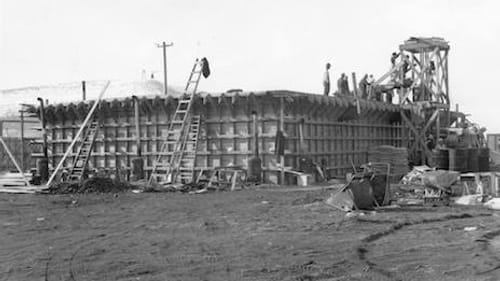Stay in the Loop
BSR publishes on a weekly schedule, with an email newsletter every Wednesday and Thursday morning. There’s no paywall, and subscribing is always free.
An American tradition
'Resistance at Tule Lake,' by Konrad Aderer

At the Philly screening of Konrad Aderer’s Resistance at Tule Lake, I might have had much in common with the young woman sitting next to me. Our grandfathers both survived World War II. Both of mine served in the U.S. Armed Forces, fighting fascism overseas. One of her grandfathers was incarcerated in California by the U.S. government for being the child of Japanese immigrants.
Before the free public screening, she asked what brought me to the Japanese American Citizens League, whose national conference landed in Center City last week. I said I came to the screening because I need to learn more about America’s concentration camps.
Her family story immediately poured out. Her great-uncle was a U.S. WWII veteran, but her grandfather spent the war in the States. She was using terms I didn’t understand: Her grandfather was “Kibei” and a “no-no.”
What I didn’t know
“People were not thinking about wartime incarceration much,” said Tule Lake director Konrad Aderer in his introduction to the film (which got its national broadcast premiere last May). But then the 2016 election happened.
Until I saw the 2015 Philadelphia premiere of Jeanne Sakata’s 2007 play Hold These Truths, I never knew that the legal battle over Japanese-American internment had reached into my own lifetime. In 1988, the U.S. government granted scant reparations and a presidential apology to the survivors. I was five years old. I would learn almost nothing about these racist prisons throughout all my years in school.
I worked to remedy that as an adult. But I never heard of Tule Lake.
Wartime incarceration
Resistance at Tule Lake follows the inmates of a camp in northern California that swelled to more than 18,000 residents in the early 1940s. One of America’s 10 concentration camps for U.S residents of Japanese descent, holding about 120,000 people in total (two-thirds of whom were naturalized or American-born U.S. citizens), Tule Lake held people who gave the wrong answers on an infamous questionnaire.
The documentary, a combination of interviews with historians and living survivors of the camps, alongside photos from inside the compound, quickly helped me understand my seatmate’s story. Japanese Americans of the time defined themselves by three main categories. Issei were people who came from Japan (some were naturalized citizens). Nisei were their American-born children. And Kibei were U.S.-born children who were sent to Japan for their education: American by birth, Japanese by culture, fluent in both languages.

After the government ripped thousands of Japanese-American U.S. residents and citizens from their lives and forced them first to processing centers and then to concentration camps, the people got a questionnaire. Two items on it caused particular outrage. Number 27: Would they serve in the U.S. military, anywhere and at any time? Number 28: Would they swear unqualified allegiance to the United States?
The Guantanamo of WWII
According to a popular narrative of U.S. history, Japanese Americans quickly and peacefully complied with every wartime demand, many serving heroically in the military. But about 18,000 people — for a variety of reasons — answered “no” to one or both of those questions. They ended up at Tule Lake, which a film commentator called the “Guantanamo” of Japanese-American internment.
The documentary explores these prisoners’ tense and complex communities, from firsthand details about FBI officers storming victims’ homes to the thousands of native-born Americans who eventually renounced their citizenship under toxic, unconstitutional duress and even sailed for Japan as the war raged. Inside Tule Lake, there were beatings, martial law, deaths by medical neglect, a murder by a U.S. Army officer who was acquitted, and a fatal farming accident that propelled the camp’s first widespread protests and labor strikes.
Residents generated their own newspapers and schools and elected representatives to communicate with the white officers and civilians who ran the camp. This fundamental attempt at democracy was swiftly punished, with leaders arrested and imprisoned for months without charges inside a brutal stockade.

Finding the words
The true stories of resistance from Tule Lake have been treated like “our dirty linen” for 70 years, a survivor says in Aderer’s film. Even today, its dangerously fractious atmosphere evokes a stigma that contradicts the prevailing patriotic narratives of Japanese-American internment. Many survivors are reluctant to admit they were held there versus other camps.
One of Aderer’s subjects renounced his citizenship, sailed to Japan, and never returned. He speaks in Japanese and details many survivors’ defiant rejection of U.S. culture in favor of their Japanese roots. A different elderly survivor regained her citizenship and lives in the United States today. “I love my country,” she insists, no matter what it did to her. Her eyes brim with tears.
When stories like Tule Lake arrive, we should make it our responsibility to be in the room. Cruel scrutiny and unconstitutional violations of nonwhite immigrants and their descendants (citizens or not) are American traditions. But maybe we can learn enough to change that.
Refugees and immigrants incarcerated on U.S. soil in the 21st century (including children in our “tender age shelters”) will, like Tule Lake’s survivors, tell their own stories. And like those inmates, today’s targets of nationalist bigotry are not homogenous. There’s no single narrative to exemplify them, and their experiences will carry different traumas, choices, loyalties, and outcomes. White U.S. citizens like me must listen to those diverse truths.
If we can’t do that, we’ve learned nothing in 80 years. And like me as I sat down to Tule Lake, we won’t even have the vocabulary for the history of our own American peers.
What, When, Where
Resistance at Tule Lake. Written and directed by Konrad Aderer. Screened by the Japanese American Citizens League of Philadelphia and Philadelphia Asian American Film and Filmmakers. July 19, 2018, at the Sheraton Philadelphia Downtown Hotel, 201 N. 17th Street, Philadelphia. Jacl.org.
Sign up for our newsletter
All of the week's new articles, all in one place. Sign up for the free weekly BSR newsletters, and don't miss a conversation.

 Alaina Johns
Alaina Johns